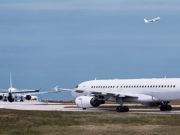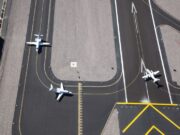
The number of aviation fatalities recorded in Australia nearly doubled in 2017 to 40, with half of those deaths occurring in general aviation operations and none in either high-capacity or low-capacity regular public transport (RPT), the Australian Transport Safety Bureau (ATSB) says (Figure 1).1
High-capacity RPT operations are those conducted in an aircraft certified as having more than 38 seats or a maximum payload capability of more than 4,200 kg (9,259 lb). Low-capacity RPT operations are those conducted in an aircraft with 38 seats or fewer or a maximum payload capability of 4,200 kg or less.
In its annual Aviation Occurrence Statistics, the ATSB reviewed data from 2008 through 2017, aiming “to provide an insight into the current and possible future trends in aviation safety.”
Looking only at 2017, the ATSB found that 196 aircraft were involved in accidents in Australia, 203 were involved in serious incidents — defined by the ATSB as incidents with a high probability of an accident — and 5,790 were involved in incidents (Figure 1). By comparison, in 2016, there were 229 accidents, 291 serious incidents and 5,419 incidents.
The 40 fatalities in 2017 exceeded the average number of fatalities recorded for the previous nine years — 33. The total number of annual occurrences generally increased over the 10-year period, although there was a slight decrease after the peak in 2013.
The number of occurrences reported annually increased for recreational aviation flights as well as medical transport, remotely piloted aircraft systems, aerial work, flying training, survey and photography, sports aviation, and search and rescue, the ATSB said. Decreases were recorded for occurrences involving charter operations and general aviation.
Figure 1 — Occurrence Data for Operation Types
Link to interactive version of this chart
Source: ATSB aviation occurrence database
The absence of fatalities in high- and low-capacity RPT operations extended a stretch of fatality-free years that began in 1975 for high-capacity RPT operations and in 2010 for low-capacity RPT flights. Of 2017’s 40 fatalities, 14 were associated with commercial air transport crashes — a category that includes high- and low-capacity RPT operations, charter flights and medical transport flights. Twenty-one of the 40 fatalities resulted from general aviation accidents and five from recreational aviation activity, the ATSB said.
ATSB data showed that aircraft control problems were the most frequently cited type of accident or serious incident involving air transport operations, followed by collisions with terrain. For general aviation, recreational aviation and remotely piloted aircraft, the most common type of accident or serious incident was terrain collision.
Bird strikes and other wildlife strikes were the most common type of incident for both commercial air transport and general aviation operations, the report said; for recreational aviation, runway events and aircraft control incidents were most common.
Looking at data for 2008 through 2017, the ATSB found that activity for commercial air transport operations has been relatively stable throughout the period (Figure 2). High-capacity RPT operations, which accounted for about 72 percent of total air transport hours in 2016, increased steadily through 2016 and declined in 2017. Complete data for all operation types in 2017 were not available.
Figure 2 — Activity Data by Operation Type, 2008–2017
Note: High-capacity regular public transport (RPT) operations include the small number of high-capacity charter operation departures or hours.
Link to interactive version of this chart.
Source: Australian Bureau of Infrastructure, Transport and Regional Economics
Figure 3 shows a fatal accident rate of 0.8 per million hours flown for all air transport aircraft, and an accident rate of 10.9 per million hours for the 2008–2017 period. The 0.0 fatal accident rate for high capacity RPT operations was matched by the 2008–2016 rate for medical transport flights; total accident rates were 1.7 per million flight hours for high-capacity RPT and 8.5 per million hours for medical transport operations.
Figure 3 — Rate of Accidents and Fatal Accidents by Operation Type, 2008–2017
RPT = regular public transport
Notes: Only high-capacity RPT and and low-capacity RPT include 2017 data. Other operation types end at 2016.
Activity data for each operation type was provided by the Australian Bureau of Infrastructure, Transport and Regional Economics, except for the following: fire control, other/unknown general aviation, foreign-registered general aviation. Except where indicated, accident and fatal accident rates are based on accidents from 2008 to 2016; 2017 activity data for all operation types was not available when the ATSB report was prepared. Private/business/sports excludes gliding.
Link to interactive version of this chart.
Source: Australian Bureau of Infrastructure, Transport and Regional Economics; ATSB aviation occurrence database
The data show a fatal accident rate of 0.8 per million hours flown for low-capacity RPT operations, and a total accident rate of 2.3 per million hours; and a fatal accident rate of 3.4 per million hours for charter operations, and a total accident rate of 39.8 per million flight hours.
Of all operation types, the highest fatal accident rate was the 30.1 per million flight hours recorded for gyrocopters, and the highest total accident rate was 300.6 per million flight hours, recorded for recreational airplanes.
Of five occurrence types recorded in Table 1, the most common were environment-related events — a broad category that included not only wildlife strikes, which numbered 13,980, but also weather events (3,426) and “interference with aircraft from ground” (182). In 2017 alone, data showed that there were 1,624 wildlife strikes, 354 weather events and 61 events attributed to interference from ground.
| Occurrence Types | 2008–2012 | 2013 | 2014 | 2015 | 2016 | 2017 | Total |
|---|---|---|---|---|---|---|---|
| ANSP = air navigation service provider; ATM = air traffic management; ATSB = Australian Transport Safety Bureau; RPA = remotely piloted aircraft (drones)
Interactive version of this table. Source: ATSB aviation occurrence database |
|||||||
| Airspace | |||||||
| Aircraft separation | 1,280 | 328 | 348 | 267 | 355 | 33 | 2,912 |
| Airspace infringement | 89 | 17 | 17 | 8 | 10 | 16 | 157 |
| ANSP operational error | 536 | 107 | 137 | 30 | 70 | 77 | 957 |
| Breakdown of coordination |
85 | 18 | 24 | 7 | 10 | 16 | 160 |
| Encounter with RPA | 0 | 1 | 9 | 14 | 60 | 109 | 193 |
| Operational noncompliance |
559 | 132 | 135 | 88 | 126 | 182 | 1,222 |
| Other | 17 | 7 | 2 | 7 | 1 | 2 | 36 |
| Consequential events | |||||||
| All | 3,799 | 859 | 832 | 812 | 779 | 740 | 7,821 |
| Environment | |||||||
| Interference with aircraft from ground | 24 | 10 | 13 | 16 | 58 | 61 | 182 |
| Weather | 1,126 | 478 | 572 | 485 | 411 | 354 | 3,426 |
| Wildlife | 6,497 | 1,437 | 1,423 | 1,415 | 1,584 | 1,624 | 13,980 |
| Infrastructure | |||||||
| ATM | 14 | 1 | 4 | 3 | 3 | 8 | 33 |
| Navigational aids | 21 | 2 | 8 | 19 | 3 | 2 | 55 |
| Other | 36 | 11 | 5 | 6 | 5 | 5 | 68 |
| Radar/surveillance | 24 | 3 | 0 | 1 | 2 | 1 | 31 |
| Runway lighting | 101 | 14 | 15 | 13 | 18 | 11 | 172 |
| Operational | |||||||
| Aircraft control | 740 | 248 | 256 | 203 | 179 | 219 | 1,845 |
| Aircraft loading | 750 | 213 | 200 | 88 | 102 | 61 | 1,414 |
| Communications | 507 | 103 | 103 | 77 | 89 | 114 | 993 |
| Crew and cabin safety | 554 | 173 | 153 | 99 | 111 | 150 | 1,240 |
| Flight preparation/ navigation |
251 | 54 | 45 | 43 | 48 | 56 | 497 |
| Fuel related | 201 | 42 | 32 | 34 | 14 | 29 | 352 |
| Fumes, smoke, fire | 1,238 | 312 | 324 | 283 | 261 | 280 | 2,698 |
| Ground operations | 339 | 67 | 68 | 48 | 67 | 63 | 652 |
| Ground proximity alerts/warnings | 189 | 173 | 222 | 250 | 194 | 278 | 1,306 |
| Miscellaneous | 1,601 | 274 | 282 | 208 | 43 | 123 | 2,531 |
| Runway events | 328 | 74 | 82 | 60 | 79 | 76 | 699 |
| Terrain Collisions | 122 | 20 | 15 | 12 | 20 | 20 | 209 |
| Technical | |||||||
| Airframe | 1,367 | 276 | 245 | 221 | 191 | 229 | 2,529 |
| Powerplant/ propulsion |
1,280 | 233 | 206 | 167 | 202 | 192 | 2,280 |
| Systems | 2,168 | 510 | 516 | 531 | 534 | 450 | 4,709 |
Table 1 also included a category for “consequential events” — defined by the ATSB as events “that happen as the result of an occurrence; for example, forced and precautionary landings, emergency descents, rejected takeoffs, evacuations and fuel dumps to reduce landing weight.”
Note
- ATSB. Aviation Research Report AR-2018-030, Aviation Occurrence Statistics, 2008 to 2017. Canberra, Australian Capital Territory, Australia. Dec. 21, 2018. https://www.atsb.gov.au/media/5775500/ar-2018-030-final.pdf


